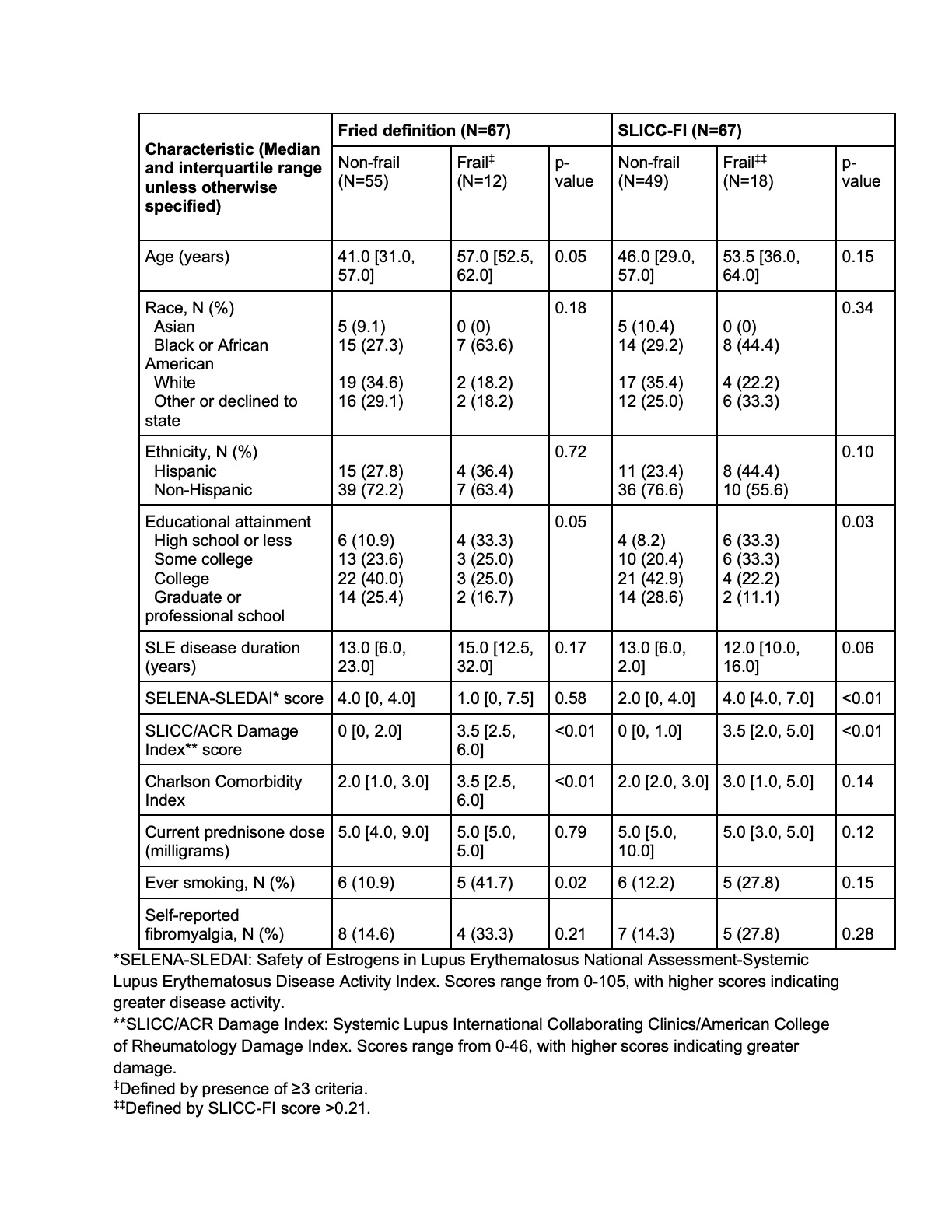Session Information
Date: Sunday, November 7, 2021
Title: SLE – Diagnosis, Manifestations, & Outcomes Poster II: Manifestations (0855–0896)
Session Type: Poster Session B
Session Time: 8:30AM-10:30AM
Background/Purpose: Frailty is a novel risk factor for adverse health outcomes in systemic lupus erythematosus (SLE). Multiple definitions of frailty, including the Fried definition (FD), a disease-agnostic phenotypic definition, and the Systemic Lupus International Collaborating Clinics Frailty Index (SLICC-FI), a SLE-specific cumulative deficits definition, have been used to measure frailty in SLE [1,2]. However, the relationship between these two definitions of frailty has not been evaluated. We aimed to determine the prevalence of frailty according to the FD and the SLICC-FI in a single center cohort of adult women with SLE, as well as the cross-sectional association of each frailty definition with self-reported disability.
Methods: Women 18-70 years of age with SLE validated according to the 1997 Update of the 1982 American College of Rheumatology Revised Classification Criteria were enrolled. Frailty status according to the FD and the SLICC-FI was measured at a single study visit. Agreement between frailty metrics was determined using a kappa statistic. Sociodemographic features, physician-reported disease activity and damage, Patient Reported Outcome Measurement Information System (PROMIS) computerized adaptive tests, and Valued Life Activities (VLA) self-report disability were assessed. Differences between frail and non-frail participants were evaluated using Fisher’s exact, Chi-squared, or Wilcoxon rank sum tests. The cross-sectional association of frailty according to each metric and VLA disability was assessed using logistic regression.
Results: Data from 67 participants were available for analysis. 12 (17.9%) and 18 (26.7%) of women were classified as frail according to the FD and the SLICC-FI, respectively. There was moderate agreement between frailty metrics (kappa = 0.41, p< 0.01). Compared to non-frail women, frail women had lesser educational attainment (FD: p=0.05; SLICC-FI: p=0.03) and greater disease damage (FD and SLICC-FI: p< 0.01) (Table 1). Frail women according to the FD were also older (p=0.05) with greater comorbidity burden (p< 0.01) and more likely to have smoked over their lifetime (p=0.02) than non-frail women (Table 1). Frail women according to the SLICC-FI had greater disease damage (p< 0.01) than non-frail women (Table 1). Frail women according to either definition had worse PROMIS scores across multiple domains (p< 0.01) and greater VLA disability (p< 0.01) than non-frail women (Table 2). After adjusting for age, frailty according to either definition was still significantly associated with greater odds of VLA disability (Table 3).
Conclusion: Frailty prevalence was higher according to the SLICC-FI than the FD in this single center cohort of women with SLE. Agreement was moderate and clinical characteristics differed between participants classified as frail according to each metric, suggesting differences in frailty constructs. Further studies are needed to explore discrepancies in frailty metrics to determine which may best predict relevant health-related outcomes in patients with SLE.
References:
1. Bandeen-Roche et al. J Gerontol A Biol Sci Med Sci 2006;61:262-6.
2. Legge et al. J Rheumatol 2020;47:72-81.
To cite this abstract in AMA style:
Lieber S, Nahid M, Legge A, Rajan M, Lipschultz R, Lin M, Mandl L. Comparison of Two Frailty Definitions in Women with Systemic Lupus Erythematosus [abstract]. Arthritis Rheumatol. 2021; 73 (suppl 9). https://acrabstracts.org/abstract/comparison-of-two-frailty-definitions-in-women-with-systemic-lupus-erythematosus/. Accessed .« Back to ACR Convergence 2021
ACR Meeting Abstracts - https://acrabstracts.org/abstract/comparison-of-two-frailty-definitions-in-women-with-systemic-lupus-erythematosus/



